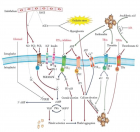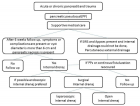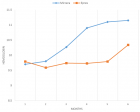Abstract
Research Article
The modified star excursion balance test for the detection of the risk of injury in elite handball female players
Noémie Drouet, Jennifer Bassement* and Franck Barbier
Published: 25 November, 2022 | Volume 7 - Issue 4 | Pages: 019-027
Background: Elite handball female players are at high risk of injury to the lower limbs. The modified Star Excursion Balance Test (mSEBT) is efficient in detecting players with a risk of injury. However, performed once before the season, the mSEBT cannot determine with precision when the injury will occur.
Purpose: The objective of the study was to investigate if a repeated measure of mSEBT across the season would help in identifying with precision the period at risk of injury for each player.
Methods: Eleven elite female handball players took part in the study. The mSEBT was measured weekly for 25 weeks and the injuries were recorded. Composite Scores (CS) and distances on each axis were computed for both legs of each player. The 94% cut-off on the composite score and the 4 cm difference between the right and left leg on the anteroposterior axis (ANT) was investigated for each player.
Results: Five players reported injury. The 94% cut-off on the CS and the 4 cm difference on ANT were not significant indicators of risk of injury in our study. However, for each injured player, a drop in the composite score was noticed the week before the injury.
Conclusion: We propose the drop of CS as an indicator for the detection of the risk of injury in a follow-up of elite athletes using repeated mSEBT. This indicator allows the detection of injury a week before it occurs. Further work is needed to confirm, investigate and validate this indicator.
Read Full Article HTML DOI: 10.29328/journal.jsmt.1001059 Cite this Article Read Full Article PDF
Keywords:
Prevention of injury; mSEBT; Composite score; Follow-up
References
- Karcher C, Buchheit M. On-court demands of elite handball, with special reference to playing positions. Sports Med. 2014 Jun;44(6):797-814. doi: 10.1007/s40279-014-0164-z. PMID: 24682948.
- Åman M, Forssblad M, Henriksson-Larsén K. Incidence and severity of reported acute sports injuries in 35 sports using insurance registry data. Scand J Med Sci Sports. 2016 Apr;26(4):451-62. doi: 10.1111/sms.12462. Epub 2015 Apr 8. PMID: 25850826.
- Luig P, Krutsch W, Nerlich M, Henke T, Klein C, Bloch H. Increased injury rates after the restructuring of Germany’s national second league of team handball. Knee Surgery, Sport Traumatol Arthrosc . 2018;26(7):1884-91. http://dx.doi.org/10.1007/s00167-018-4851-4
- Myklebust G, Maehlum S, Engebretsen L, Strand T, Solheim E. Registration of cruciate ligament injuries in Norwegian top level team handball. A prospective study covering two seasons. Scand J Med Sci Sports. 1997 Oct;7(5):289-92. doi: 10.1111/j.1600-0838.1997.tb00155.x. PMID: 9338947.
- Myklebust G, Maehlum S, Engebretsen L, Strand T, Solheim E. Registration of cruciate ligament injuries in Norwegian top level team handball. A prospective study covering two seasons. Scand J Med Sci Sports. 1997 Oct;7(5):289-92. doi: 10.1111/j.1600-0838.1997.tb00155.x. PMID: 9338947.
- Langevoort G, Myklebust G, Dvorak J, Junge A. Handball injuries during major international tournaments. Scand J Med Sci Sports. 2007 Aug;17(4):400-7. doi: 10.1111/j.1600-0838.2006.00587.x. Epub 2006 Oct 12. PMID: 17038157.
- Laver L, Luig P, Achenbach L, Myklebust G, Karlsson J. Handball Injuries: Epidemiology and Injury Characterization: Part 1. Handball Sport Med. 2018;141-53.
- Holdhaus H. Injury Study Ehf Women’s Euro 2010 in Denmark & Norway. EHF web Periodical. 2010;5. http://www.eurohandball.com/publications
- van Mechelen W, Hlobil H, Kemper HC. Incidence, severity, aetiology and prevention of sports injuries. A review of concepts. Sports Med. 1992 Aug;14(2):82-99. doi: 10.2165/00007256-199214020-00002. PMID: 1509229.
- Dauty M, Louvet S, Potiron-Josse M, Dubois C. Désentraînement et réentraînement du cycliste de haut niveau immobilisé par blessure [Detraining and retraining after injury in a high-level cyclist]. Ann Readapt Med Phys. 2005 Mar;48(2):93-100. French. doi: 10.1016/j.annrmp.2004.09.006. Epub 2005 Jan 12. PMID: 15748774.
- Vigelsø A, Gram M, Wiuff C, Andersen JL, Helge JW, Dela F. Six weeks' aerobic retraining after two weeks' immobilization restores leg lean mass and aerobic capacity but does not fully rehabilitate leg strength in young and older men. J Rehabil Med. 2015 Jun;47(6):552-60. doi: 10.2340/16501977-1961. PMID: 25898161.
- Bahr R, Krosshaug T. Understanding injury mechanisms: a key component of preventing injuries in sport. Br J Sports Med. 2005 Jun;39(6):324-9. doi: 10.1136/bjsm.2005.018341. PMID: 15911600; PMCID: PMC1725226.
- Steffen K, Andersen TE, Krosshaug T, van Mechelen W, Myklebust G, Verhagen EA. Ecss position statement 2009: Prevention of acute sports injuries. Eur J Sport Sci. 2010;10(4):223–36.
- Collings TJ, Bourne MN, Barrett RS, du Moulin W, Hickey JT, Diamond LE. Risk Factors for Lower Limb Injury in Female Team Field and Court Sports: A Systematic Review, Meta-analysis, and Best Evidence Synthesis. Sports Med. 2021;51(4):759–76. https://doi.org/10.1007/s40279-020-01410-9
- Buffet M, Morel N, Navacchia M, Voyez J, Vella-Boucaud J, Edouard P. Blessures chez des joueuses de basketball féminin de haut niveau durant une saison. Sci Sport . 2015;30(3):134–46. http://dx.doi.org/10.1016/j.scispo.2015.02.008
- Von Rosen P, Kottorp A, Fridén C, Frohm A, Heijne A. Young, talented and injured: Injury perceptions, experiences, and consequences in adolescent elite athletes. Eur J Sport Sci . 2018;18(5):731–40. https://doi.org/10.1080/17461391.2018.1440009
- Plisky PJ, Rauh MJ, Kaminski TW, Underwood FB. Star Excursion Balance Test as a predictor of lower extremity injury in high school basketball players. J Orthop Sports Phys Ther. 2006 Dec;36(12):911-9. doi: 10.2519/jospt.2006.2244. PMID: 17193868.
- Gribble PA, Hertel J, Plisky P. Using the Star Excursion Balance Test to assess dynamic postural-control deficits and outcomes in lower extremity injury: a literature and systematic review. J Athl Train. 2012 May-Jun;47(3):339-57. doi: 10.4085/1062-6050-47.3.08. PMID: 22892416; PMCID: PMC3392165.
- Picot B, Terrier R, Forestier N, Fourchet F, McKeon PO. The Star Excursion Balance Test: An Update Review and Practical Guidelines. Int J Athl Ther Train. 2021;26(6):285–93.
- Olmsted LC, Carcia CR, Hertel J, Shultz SJ. Efficacy of the Star Excursion Balance Tests in Detecting Reach Deficits in Subjects With Chronic Ankle Instability. J Athl Train. 2002 Dec;37(4):501-506. PMID: 12937574; PMCID: PMC164384.
- Smith CA, Chimera NJ, Warren M. Association of y balance test reach asymmetry and injury in division I athletes. Med Sci Sports Exerc. 2015 Jan;47(1):136-41. doi: 10.1249/MSS.0000000000000380. PMID: 24870573.
- Gonell AC, Romero JA, Soler LM. Relationship between the y balance test scores and soft tissue injury incidence in a soccer team. Int J Sports Phys Ther. 2015 Dec;10(7):955-66. PMID: 26673848; PMCID: PMC4675196.
- Udompanich N, Thanasootr KO, Chanavirut R, Chatchawan U, Hunsawong T. The Cut-Off Score of Four Clinical Tests to Quantify Balance Impairment in Individuals with Chronic Ankle Instability. Malays J Med Sci. 2021 Aug;28(4):87-96. doi: 10.21315/mjms2021.28.4.9. Epub 2021 Aug 26. PMID: 34512133; PMCID: PMC8407791.
- Robinson RH, Gribble PA. Support for a reduction in the number of trials needed for the star excursion balance test. Arch Phys Med Rehabil. 2008 Feb;89(2):364-70. doi: 10.1016/j.apmr.2007.08.139. PMID: 18226664.
- van Lieshout R, Reijneveld EA, van den Berg SM, Haerkens GM, Koenders NH, de Leeuw AJ, van Oorsouw RG, Paap D, Scheffer E, Weterings S, Stukstette MJ. Reproducibility of the modified star excursion balance test composite and specific reach direction scores. Int J Sports Phys Ther. 2016 Jun;11(3):356-65. PMID: 27274422; PMCID: PMC4886804.
- Bulow A, Anderson JE, Leiter JR, MacDonald PB, Peeler J. The modified star excursion balance and y-balance test results differ when assessing physically active healthy adolescent females. Int J Sports Phys Ther. 2019 Apr;14(2):192-203. PMID: 30997272; PMCID: PMC6449011.
- Gribble PA, Tucker WS, White PA. Time-of-day influences on static and dynamic postural control. J Athl Train. 2007 Jan-Mar;42(1):35-41. PMID: 17597941; PMCID: PMC1896064.
- Picot B, Terrier R, Forestier N. Le Star Excursion Balance Test : Mise à jour et recommandation sur son utilisation en pratique The Star Excursion Balnce Test: up-date, recommendations and pratical guidelines. Mains Libr. 2018; 4 :9–16.
- Hertel J, Braham RA, Hale SA, Olmsted-Kramer LC. Simplifying the star excursion balance test: analyses of subjects with and without chronic ankle instability. J Orthop Sports Phys Ther. 2006 Mar;36(3):131-7. doi: 10.2519/jospt.2006.36.3.131. PMID: 16596889.
- Butler RJ, Lehr ME, Fink ML, Kiesel KB, Plisky PJ. Dynamic balance performance and noncontact lower extremity injury in college football players: an initial study. Sports Health. 2013 Sep;5(5):417-22. doi: 10.1177/1941738113498703. PMID: 24427412; PMCID: PMC3752196.
- Picot B, Dury J, Néron G, McKeon PO, Forestier N. Establishing Normative Dynamic Postural Control Values in Elite Female Handball Players. Int J Sports Phys Ther. 2022 Oct 1;17(6):1083-1094. doi: 10.26603/001c.38174. PMID: 36237642; PMCID: PMC9528723.
- Hoch MC, Staton GS, Medina McKeon JM, Mattacola CG, McKeon PO. Dorsiflexion and dynamic postural control deficits are present in those with chronic ankle instability. J Sci Med Sport . 2012;15(6):574–9. http://dx.doi.org/10.1016/j.jsams.2012.02.009
- Fullam K, Caulfield B, Coughlan GF, Delahunt E. Kinematic analysis of selected reach directions of the Star Excursion Balance Test compared with the Y-Balance Test. J Sport Rehabil. 2014 Feb;23(1):27-35. doi: 10.1123/jsr.2012-0114. Epub 2013 Aug 12. PMID: 23945793.
- Kaminski TW, Gribble P. The Star Excursion Balance Test as a Measurement Tool. Athl Ther Today. 2016;8(2):46–7.
- Seil R, Rupp S, Tempelhof S, Kohn D. Sports injuries in team handball. A one-year prospective study of sixteen men's senior teams of a superior nonprofessional level. Am J Sports Med. 1998 Sep-Oct;26(5):681-7. doi: 10.1177/03635465980260051401. PMID: 9784816.
- Hertel J, Miller SJ, Denegar CR. Intratester and intertester reliability during the star excursion balance tests. J Sport Rehabil. 2000;9(2):104–16.
- Lim JS, Kim S, Moon I, Yi C. The Effects of Elastic Ankle Taping on Static and Dynamic Postural Control in Individuals With Chronic Ankle Instability. Phys Ther Korea. 2021;28(3):200–7.
- Horsak B, Simonlehner M, Dumphart B, Kainz H, Killen B, Jonkers I. Patella-femoral joint loading during the modified Star Excursion Balance Test: Preliminary results of an extensive simulation study. Gait Posture. 2022 ;97:S5–6.
- Coughlan GF, Fullam K, Delahunt E, Gissane C, Caulfield BM. A comparison between performance on selected directions of the star excursion balance test and the Y balance test. J Athl Train. 2012 Jul-Aug;47(4):366-71. doi: 10.4085/1062-6050-47.4.03. PMID: 22889651; PMCID: PMC3396295.
- Lee DK, Kim GM, Ha SM, Oh JS. Correlation of the Y-Balance Test with Lower-limb Strength of Adult Women. J Phys Ther Sci. 2014 May;26(5):641-3. doi: 10.1589/jpts.26.641. Epub 2014 May 29. PMID: 24926122; PMCID: PMC4047222.
- Onofrei RR, Amaricai E, Petroman R, Surducan D, Suciu O. Preseason Dynamic Balance Performance in Healthy Elite Male Soccer Players. Am J Mens Health. 2019 Jan-Feb;13(1):1557988319831920. doi: 10.1177/1557988319831920. PMID: 30776956; PMCID: PMC6775551.
- Philp F, Telford C, Reid D, Mccluskey M. Establishing normative performance values of modified Star Excursion Balance Test (mSEBT) and Limb 4 Symmetry Index (LSI) scores and their relationship to age in female adolescent footballers. 2019.
- Stiffler MR, Bell DR, Sanfilippo JL, Hetzel SJ, Pickett KA, Heiderscheit BC. Star Excursion Balance Test Anterior Asymmetry is Associated with Injury Status in Division I Collegiate Athletes. J Orthop Sports Phys Ther . 2017;47(5):339–45.
Figures:

Figure 1

Figure 2

Figure 3

Figure 4
Similar Articles
-
The modified star excursion balance test for the detection of the risk of injury in elite handball female playersNoémie Drouet,Jennifer Bassement*,Franck Barbier. The modified star excursion balance test for the detection of the risk of injury in elite handball female players. . 2022 doi: 10.29328/journal.jsmt.1001059; 7: 019-027
Recently Viewed
-
Trends in TeledentistryRudrakshi C*. Trends in Teledentistry. J Clin Adv Dent. 2020: doi: 10.29328/journal.jcad.1001014; 4: 004-005
-
Au26-35: A Special Geometrical Structure of Au33 (D2) Cluster with Highly Occupied - 14 Pairs of Double-State DegeneracyK Vishwanathan*. Au26-35: A Special Geometrical Structure of Au33 (D2) Cluster with Highly Occupied - 14 Pairs of Double-State Degeneracy. Ann Adv Chem. 2022: doi: 10.29328/journal.aac.1001035; 6: 063-080
-
Texture of Thin Films of Aluminum Nitride Produced by Magnetron SputteringStrunin Vladimir Ivanovich,Baranova Larisa Vasilievna*,Baisova Bibigul Tulegenovna. Texture of Thin Films of Aluminum Nitride Produced by Magnetron Sputtering. Int J Phys Res Appl. 2025: doi: 10.29328/journal.ijpra.1001106; 8: 013-016
-
Minimising Carbon Footprint in Anaesthesia PracticeNisha Gandhi and Abinav Sarvesh SPS*. Minimising Carbon Footprint in Anaesthesia Practice. Int J Clin Anesth Res. 2024: doi: 10.29328/journal.ijcar.1001025; 8: 005-007
-
On Friedman equation, quadratic laws and the geometry of our universeS Kalimuthu*. On Friedman equation, quadratic laws and the geometry of our universe. Int J Phys Res Appl. 2021: doi: 10.29328/journal.ijpra.1001041; 4: 048-050
Most Viewed
-
Evaluation of Biostimulants Based on Recovered Protein Hydrolysates from Animal By-products as Plant Growth EnhancersH Pérez-Aguilar*, M Lacruz-Asaro, F Arán-Ais. Evaluation of Biostimulants Based on Recovered Protein Hydrolysates from Animal By-products as Plant Growth Enhancers. J Plant Sci Phytopathol. 2023 doi: 10.29328/journal.jpsp.1001104; 7: 042-047
-
Sinonasal Myxoma Extending into the Orbit in a 4-Year Old: A Case PresentationJulian A Purrinos*, Ramzi Younis. Sinonasal Myxoma Extending into the Orbit in a 4-Year Old: A Case Presentation. Arch Case Rep. 2024 doi: 10.29328/journal.acr.1001099; 8: 075-077
-
Feasibility study of magnetic sensing for detecting single-neuron action potentialsDenis Tonini,Kai Wu,Renata Saha,Jian-Ping Wang*. Feasibility study of magnetic sensing for detecting single-neuron action potentials. Ann Biomed Sci Eng. 2022 doi: 10.29328/journal.abse.1001018; 6: 019-029
-
Pediatric Dysgerminoma: Unveiling a Rare Ovarian TumorFaten Limaiem*, Khalil Saffar, Ahmed Halouani. Pediatric Dysgerminoma: Unveiling a Rare Ovarian Tumor. Arch Case Rep. 2024 doi: 10.29328/journal.acr.1001087; 8: 010-013
-
Physical activity can change the physiological and psychological circumstances during COVID-19 pandemic: A narrative reviewKhashayar Maroufi*. Physical activity can change the physiological and psychological circumstances during COVID-19 pandemic: A narrative review. J Sports Med Ther. 2021 doi: 10.29328/journal.jsmt.1001051; 6: 001-007

HSPI: We're glad you're here. Please click "create a new Query" if you are a new visitor to our website and need further information from us.
If you are already a member of our network and need to keep track of any developments regarding a question you have already submitted, click "take me to my Query."


















































































































































